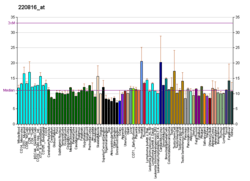LPAR3
Lysophosphatidic acid receptor 3 also known as LPA3 is a protein that in humans is encoded by the LPAR3 gene.[5][6] LPA3 is a G protein-coupled receptor that binds the lipid signaling molecule lysophosphatidic acid (LPA).[7]
Function
This gene encodes a member of the G protein-coupled receptor family, as well as the EDG family of proteins. This protein functions as a cellular receptor for lysophosphatidic acid and mediates lysophosphatidic acid-evoked calcium mobilization. This receptor couples predominantly to G(q/11) alpha proteins.[5]
See also
References
- 1 2 3 GRCh38: Ensembl release 89: ENSG00000171517 - Ensembl, May 2017
- 1 2 3 GRCm38: Ensembl release 89: ENSMUSG00000036832 - Ensembl, May 2017
- ↑ "Human PubMed Reference:".
- ↑ "Mouse PubMed Reference:".
- 1 2 "Entrez Gene: LPAR3 Lysophosphatidic acid receptor 3".
- ↑ Bandoh K, Aoki J, Hosono H, Kobayashi S, Kobayashi T, Murakami-Murofushi K, Tsujimoto M, Arai H, Inoue K (September 1999). "Molecular cloning and characterization of a novel human G-protein-coupled receptor, EDG7, for lysophosphatidic acid". J. Biol. Chem. 274 (39): 27776–85. doi:10.1074/jbc.274.39.27776. PMID 10488122.
- ↑ Choi JW, Herr DR, Noguchi K, Yung YC, Lee CW, Mutoh T, Lin ME, Teo ST, Park KE, Mosley AN, Chun J (January 2010). "LPA Receptors: Subtypes and Biological Actions". Annual Review of Pharmacology and Toxicology. 50 (1): 157–186. doi:10.1146/annurev.pharmtox.010909.105753. PMID 20055701.
Further reading
- Contos JJ, Ishii I, Chun J (2001). "Lysophosphatidic acid receptors". Mol. Pharmacol. 58 (6): 1188–96. PMID 11093753.
- Im DS, Heise CE, Harding MA, et al. (2000). "Molecular cloning and characterization of a lysophosphatidic acid receptor, Edg-7, expressed in prostate". Mol. Pharmacol. 57 (4): 753–9. PMID 10727522.
- Fitzgerald LR, Dytko GM, Sarau HM, et al. (2000). "Identification of an EDG7 variant, HOFNH30, a G-protein-coupled receptor for lysophosphatidic acid". Biochem. Biophys. Res. Commun. 273 (3): 805–10. doi:10.1006/bbrc.2000.2943. PMID 10891327.
- Tokumura A, Sinomiya J, Kishimoto S, et al. (2002). "Human platelets respond differentially to lysophosphatidic acids having a highly unsaturated fatty acyl group and alkyl ether-linked lysophosphatidic acids". Biochem. J. 365 (Pt 3): 617–28. doi:10.1042/BJ20020348. PMC 1222725. PMID 11982483.
- Hama K, Bandoh K, Kakehi Y, et al. (2002). "Lysophosphatidic acid (LPA) receptors are activated differentially by biological fluids: possible role of LPA-binding proteins in activation of LPA receptors". FEBS Lett. 523 (1–3): 187–92. doi:10.1016/S0014-5793(02)02976-9. PMID 12123830.
- Strausberg RL, Feingold EA, Grouse LH, et al. (2003). "Generation and initial analysis of more than 15,000 full-length human and mouse cDNA sequences". Proc. Natl. Acad. Sci. U.S.A. 99 (26): 16899–903. doi:10.1073/pnas.242603899. PMC 139241. PMID 12477932.
- Cremers B, Flesch M, Kostenis E, et al. (2003). "Modulation of myocardial contractility by lysophosphatidic acid (LPA)". J. Mol. Cell. Cardiol. 35 (1): 71–80. doi:10.1016/S0022-2828(02)00279-1. PMID 12623301.
- Fujita T, Miyamoto S, Onoyama I, et al. (2003). "Expression of lysophosphatidic acid receptors and vascular endothelial growth factor mediating lysophosphatidic acid in the development of human ovarian cancer". Cancer Lett. 192 (2): 161–9. doi:10.1016/S0304-3835(02)00713-9. PMID 12668280.
- Jin Y, Knudsen E, Wang L, Maghazachi AA (2003). "Lysophosphatidic acid induces human natural killer cell chemotaxis and intracellular calcium mobilization". Eur. J. Immunol. 33 (8): 2083–9. doi:10.1002/eji.200323711. PMID 12884281.
- Xing Y, Ganji SH, Noh JW, Kamanna VS (2005). "Cell density-dependent expression of EDG family receptors and mesangial cell proliferation: role in lysophosphatidic acid-mediated cell growth". Am. J. Physiol. Renal Physiol. 287 (6): F1250–7. doi:10.1152/ajprenal.00342.2003. PMID 15292052.
- Gerhard DS, Wagner L, Feingold EA, et al. (2004). "The status, quality, and expansion of the NIH full-length cDNA project: the Mammalian Gene Collection (MGC)". Genome Res. 14 (10B): 2121–7. doi:10.1101/gr.2596504. PMC 528928. PMID 15489334.
External links
- "Lysophospholipid Receptors: LPA3". IUPHAR Database of Receptors and Ion Channels. International Union of Basic and Clinical Pharmacology.
This article incorporates text from the United States National Library of Medicine, which is in the public domain.
This article is issued from
Wikipedia.
The text is licensed under Creative Commons - Attribution - Sharealike.
Additional terms may apply for the media files.




